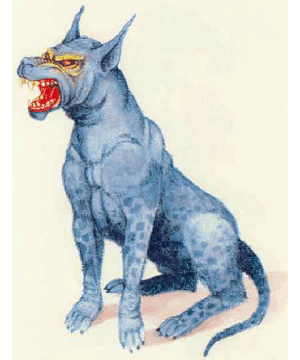

2501

| Climate/Terrain: | Any land |
|---|---|
| Frequency: | Very rare |
| Organization: | Solitary or pack |
| Activity Cycle: | Night |
| Diet: | Carnivore |
| Intelligence: | Semi- (2-4) |
| Treasure: | Nil |
| Alignment: | Chaotic evil |
| No. Appearing: | 2d4 |
| Armor Class: | 0 |
| Movement: | 15, Fl 27 (C) |
| Hit Dice: | 3+3 |
| THAC0: | 17 |
| No. of Attacks: | 1 |
| Damage/Attack: | 2d4 (bite) |
| Special Attacks: | Baying |
| Special Defenses: | Hit only by silver or magical weapons for minimal damage |
| Magic Resistance: | Nil |
| Size: | M (4� long) |
| Morale: | Fanatic (18) |
| XP Value: | 1,400 |
Yowlers look like huge, well-muscled hounds. Their short fur is as dull and black as chimney soot. Though a yowler�s overall appearance is canine, its expression can be decidedly human, and its wrinkled ears could easily be mistaken for stubby horns. A yowler�s eyes glow an infernal red; its teeth are yellow and well-designed for tearing flesh from unfortunate victims.
Combat: A yowler�s baying is a horrible sound, clearly audible at distances of up to a mile and carrying considerably farther under the right conditions. Creatures within 90 feet of a baying yowler must make a successful saving throw vs. spell or flee in panic until they can no longer hear the sound. If five or more yowlers bay at once, the saving throw is made with a -1 penalty, with the penalty increasing by 1 point for each additional yowler beyond the fifth (to a maximum of -10). Creatures who make a successful saving throw are immune to that particular pack�s baying for the remainder of the encounter.
When a pack of yowlers attacks a group of foes, the yowlers begin their bay, hoping to cause their enemies to scatter in fear. If some opponents flee, the bulk of the pack use their flying abilities to chase down and gang up on one or two panicked targets while a few remain behind to distract nonpanicked opponents. As long as there is at least one panicked quarry, one or more yowlers will continue to bay rather than attack.
Panicked characters flee at top speed in a random direction, but they always move away from the baying. Fleeing characters do not defend themselves unless cornered. In that case, they fight normally but turn to flee again at the first opportunity. A fleeing character drops any item held 50% of the time. Magical silence blocks the effect, but the victim will flee in terror once again if the sound returns.
In melee, yowlers attack by biting for 2d4 points of damage. Their flying abilities enable them to dart in for swooping attacks while remaining out of their foes� reach most of the time.
Yowlers are harmed only by silver or magical weapons. These weapons inflict damage equal only to the weapon�s magical bonus. For example, a dagger +4 inflicts 1 point of damage, and a two-handed sword +2 inflicts 2 points of damage. A silver weapon inflicts 1 point of damage. Damage bonuses due to the wielder�s Strength or specialization do not apply.
Habitat/Society: Fortunately, yowlers inhabit only the most desolate wilderness. They often lair in dismal caves where they rest during the day. A yowler pack usually claims a territory of about 200 square miles. They tend to attack any warm-blooded creature that enters the territory and ferociously drive away other carnivores, including other yowlers, whenever they appear.
Tales are sometimes told of evil creatures using yowlers as hunting or guard beasts, but even yowler pups are stubborn, hostile, and nearly impossible to train. They cannot be truly domesticated and will run away or turn on their masters if given the slightest chance.
Yowler packs are loosely organized along the same lines as wolf packs, with one dominant, breeding pair and several junior members who act as expendable scouts, hunters, and fighters. The dominant members are frequently subjected to challenges from the junior members, and the loser in a dominance struggle is usually killed, though some manage to flee. Lone yowler encounters are usually with individuals that have escaped death after a dominance fight.
The dominant pair of yowlers aggressively defend their pups, and the additional pack members are responsible for bringing food to the pups and their mother. When a yowler pack grows too large to support itself in the available territory, several juniors will break off to establish a new territory and form a new pack.
Ecology: Yowlers can eat any type of meat, but demihuman flesh is their favorite. They will scavenge if necessary, but few edible creatures within their territories get the chance to die naturally.
Last Modified: March 18, 2010, 21:38:18 GMT

◆ 2021 ◆